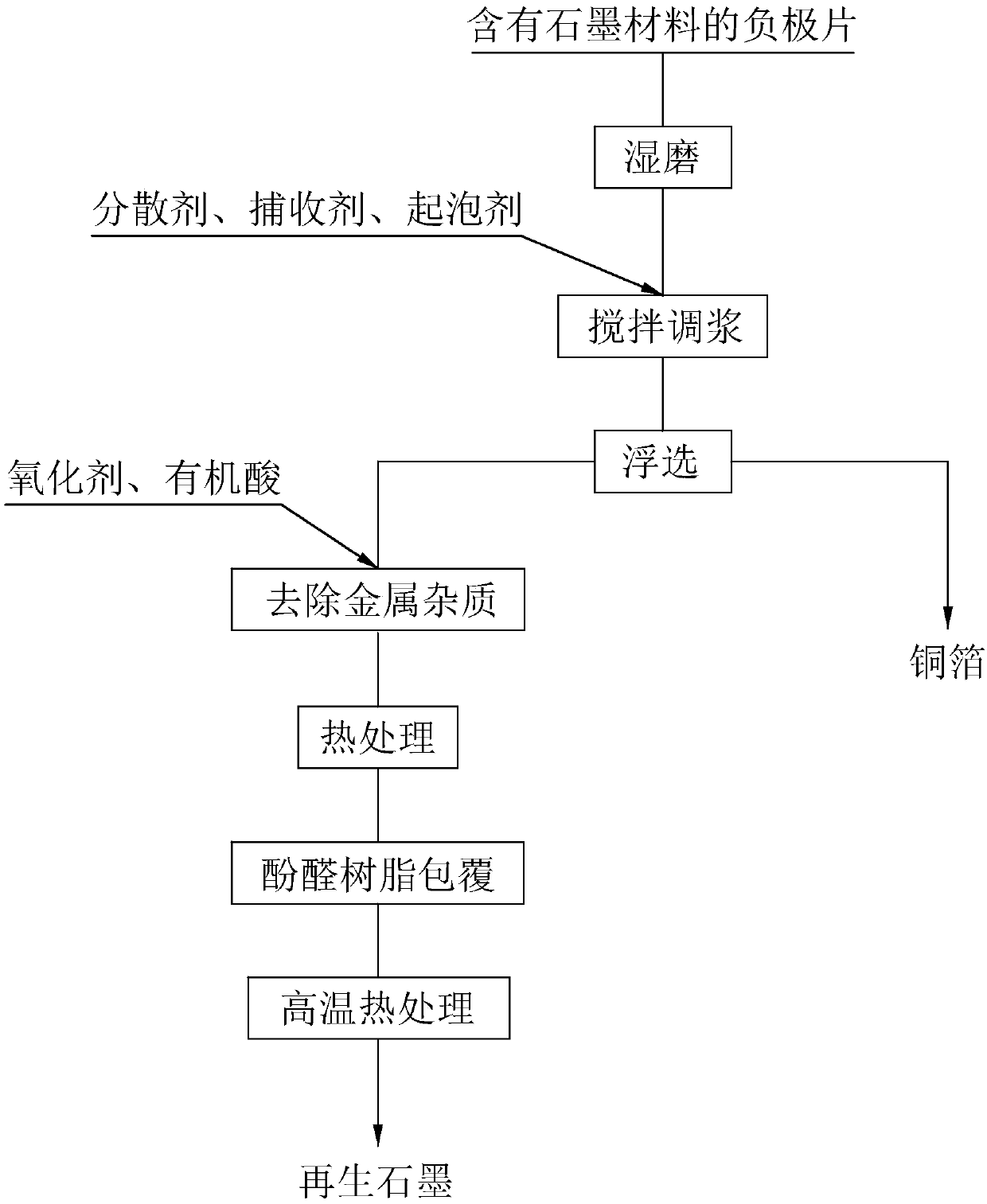A recovery and regeneration process for a waste battery graphite material
A technology for graphite materials and waste batteries, which is applied in the field of recycling and regeneration of graphite materials for waste batteries, can solve problems such as resource waste, impact, environment and even human health problems, achieve high recovery rate, improve purity and production efficiency, and reduce impurities The effect of content
- Summary
- Abstract
- Description
- Claims
- Application Information
AI Technical Summary
Problems solved by technology
Method used
Image
Examples
Embodiment 1
[0036] In this embodiment, the negative electrode sheet containing graphite material in the waste battery is put into a rod mill for wet grinding to separate the copper foil as a current collector from the negative electrode powder adhering to the surface of the copper foil, and during the wet grinding process The solid content is controlled at 15 wt% by adding water, and the wet milling is completed after 10 minutes, and the mixed liquid containing the copper foil and the negative electrode powder is transferred to a high turbulence mixing equipment for stirring and mixing.
[0037] During the pulping process, the solid content is controlled at 5wt% by adding water, and sodium silicate as a dispersant, kerosene as a collector and terpineol oil as a foaming agent are added, and sodium silicate, kerosene and pine The amount of alcohol oil added relative to the total mass of the copper foil and the negative electrode powder is 100 g / t, 100 g / t, and 100 g / t, respectively.
[0038...
Embodiment 2
[0042] In this embodiment, the negative electrode sheet containing graphite material in the waste battery is put into a rod mill for wet grinding to separate the copper foil as a current collector from the negative electrode powder adhering to the surface of the copper foil, and during the wet grinding process The solid content is controlled at 25wt% by adding water, and the wet grinding is completed after 20 minutes, and the mixed liquid containing the copper foil and the negative electrode powder is transferred to a high turbulence mixing equipment for stirring and mixing.
[0043] During the pulping process, the solid content is controlled at 8wt% by adding water, and sodium hexametaphosphate as a dispersant, kerosene as a collector and pine oil as a foaming agent are added, and sodium hexametaphosphate, kerosene And the addition amount of terpineol oil relative to the total mass of the copper foil and the negative electrode powder is 150g / t, 200g / t, 150g / t respectively.
...
Embodiment 3
[0048] In this embodiment, the negative electrode sheet containing graphite material in the waste battery is put into a rod mill for wet grinding to separate the copper foil as a current collector from the negative electrode powder adhering to the surface of the copper foil, and during the wet grinding process The solid content is controlled at 30wt% by adding water, and the wet grinding is completed after 30 minutes, and the mixed liquid containing the copper foil and the negative electrode powder is transferred to a high-turbulence mixing equipment for stirring and mixing.
[0049] During the pulping process, the solid content is controlled at 10wt% by adding water, and sodium silicate as a dispersant, kerosene as a collector and pine alcohol oil as a foaming agent are added, and sodium silicate, kerosene and pine The amount of alcohol oil added relative to the total mass of the copper foil and the negative electrode powder is 200g / t, 400g / t, and 200g / t, respectively.
[005...
PUM
 Login to view more
Login to view more Abstract
Description
Claims
Application Information
 Login to view more
Login to view more - R&D Engineer
- R&D Manager
- IP Professional
- Industry Leading Data Capabilities
- Powerful AI technology
- Patent DNA Extraction
Browse by: Latest US Patents, China's latest patents, Technical Efficacy Thesaurus, Application Domain, Technology Topic.
© 2024 PatSnap. All rights reserved.Legal|Privacy policy|Modern Slavery Act Transparency Statement|Sitemap

